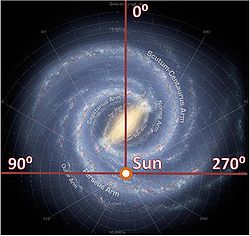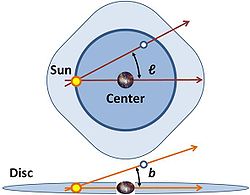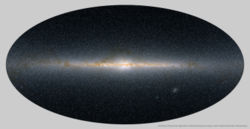
Galactic coordinate system
Encyclopedia

Celestial coordinate system
In astronomy, a celestial coordinate system is a coordinate system for mapping positions on the celestial sphere.There are different celestial coordinate systems each using a system of spherical coordinates projected on the celestial sphere, in analogy to the geographic coordinate system used on...
which is centered on the Sun
Sun
The Sun is the star at the center of the Solar System. It is almost perfectly spherical and consists of hot plasma interwoven with magnetic fields...
and is aligned with the apparent center of the Milky Way galaxy. The "equator
Equator
An equator is the intersection of a sphere's surface with the plane perpendicular to the sphere's axis of rotation and containing the sphere's center of mass....
" is aligned to the galactic plane
Galactic plane
The galactic plane is the plane in which the majority of a disk-shaped galaxy's mass lies. The directions perpendicular to the galactic plane point to the galactic poles...
. Similar to geographic coordinates, positions in the galactic coordinate system have latitude
Latitude
In geography, the latitude of a location on the Earth is the angular distance of that location south or north of the Equator. The latitude is an angle, and is usually measured in degrees . The equator has a latitude of 0°, the North pole has a latitude of 90° north , and the South pole has a...
s and longitude
Longitude
Longitude is a geographic coordinate that specifies the east-west position of a point on the Earth's surface. It is an angular measurement, usually expressed in degrees, minutes and seconds, and denoted by the Greek letter lambda ....
s.
Notation
The symbols ℓ and b are used to represent the galactic longitude and latitude, respectively. The galactic longitude is measured in the plane of the galaxy using an axis pointing from the Sun to the galactic center. The galactic latitude is measured from the plane of the galaxy to the object using the Sun as vertexVertex (geometry)
In geometry, a vertex is a special kind of point that describes the corners or intersections of geometric shapes.-Of an angle:...
.
Definition

International Astronomical Union
The International Astronomical Union IAU is a collection of professional astronomers, at the Ph.D. level and beyond, active in professional research and education in astronomy...
(IAU) defined the galactic coordinate system in reference to the Equatorial coordinate system
Equatorial coordinate system
The equatorial coordinate system is a widely-used method of mapping celestial objects. It functions by projecting the Earth's geographic poles and equator onto the celestial sphere. The projection of the Earth's equator onto the celestial sphere is called the celestial equator...
in 1958 The north galactic pole is defined to be at right ascension
Right ascension
Right ascension is the astronomical term for one of the two coordinates of a point on the celestial sphere when using the equatorial coordinate system. The other coordinate is the declination.-Explanation:...
, declination
Declination
In astronomy, declination is one of the two coordinates of the equatorial coordinate system, the other being either right ascension or hour angle. Declination in astronomy is comparable to geographic latitude, but projected onto the celestial sphere. Declination is measured in degrees north and...
(B1950) in the constellation Coma Berenices
Coma Berenices
Coma Berenices is a traditional asterism that has since been defined as one of the 88 modern constellations. It is located near Leo, to which it formerly belonged, and accommodates the North Galactic Pole...
, and the zero of longitude is the great semicircle that originates from this point along the line in position angle
Position angle
Position angle, usually abbreviated PA, is a measurement derived from observing visual binary stars. It is defined as the angular offset in degrees of the secondary star to the primary, relative to the north celestial pole....
123° with respect to the equatorial pole. The galactic longitude increases in the same direction as right ascension. Galactic latitude is positive towards the north galactic pole, the poles themselves at ±90° and the galactic equator being zero. The south galactic pole is in the constellation Sculptor
Sculptor (constellation)
Sculptor is a small and faint constellation in the southern sky. It represents a sculptor. It was introduced by Nicolas Louis de Lacaille in the 18th century. He originally named it Apparatus Sculptoris , but the name was later shortened.-Notable features:No stars brighter than 3rd magnitude are...
.
The equivalent system referred to as J2000 has the north galactic pole at (J2000) (192.859508, 27.128336 in decimal degrees), the zero of longitude at the position angle of 122.932°. The point in the sky at which the galactic latitude and longitude are both zero is (J2000) (266.405100, -28.936175 in decimal degrees). This is offset slightly from the radio source Sagittarius A*, which is the best physical marker of the true galactic center
Galactic Center
The Galactic Center is the rotational center of the Milky Way galaxy. It is located at a distance of 8.33±0.35 kpc from the Earth in the direction of the constellations Sagittarius, Ophiuchus, and Scorpius where the Milky Way appears brightest...
. Sagittarius A* is located at (J2000), or galactic longitude , galactic latitude .
The galactic equator runs through the following constellation
Constellation
In modern astronomy, a constellation is an internationally defined area of the celestial sphere. These areas are grouped around asterisms, patterns formed by prominent stars within apparent proximity to one another on Earth's night sky....
s:
|
Camelopardalis Camelopardalis is a large but faint constellation in the northern sky. The constellation was introduced in 1612 by Petrus Plancius. Some older astronomy books give an alternative spelling of the name, Camelopardus.-Etymology:... Perseus (constellation) Perseus is a constellation in the northern sky, named after the Greek hero Perseus. It was one of the 48 constellations listed by the 2nd century astronomer Ptolemy, and remains one of the 88 modern constellations defined by the International Astronomical Union... Auriga (constellation) Auriga is a constellation in the northern sky. Its name is Latin for 'charioteer' and its stars form a shape that has been associated with the pointed helmet of a charioteer. It was one of the 48 constellations listed by the 2nd century astronomer Ptolemy, and remains among the 88 modern... Taurus (constellation) Taurus is one of the constellations of the zodiac. Its name is a Latin word meaning 'bull', and its astrological symbol is a stylized bull's head:... Gemini (constellation) Gemini is one of the constellations of the zodiac. It was one of the 48 constellations described by the 2nd century astronomer Ptolemy and it remains one of the 88 modern constellations today. Its name is Latin for "twins", and it is associated with the twins Castor and Pollux in Greek mythology... Orion (constellation) Orion, often referred to as The Hunter, is a prominent constellation located on the celestial equator and visible throughout the world. It is one of the most conspicuous, and most recognizable constellations in the night sky... Monoceros Monoceros is a faint constellation on the celestial equator. Its name is Greek for unicorn. Its definition is attributed to the 17th-century Dutch cartographer Petrus Plancius. It is bordered by Orion to the west, Gemini to the north, Canis Major to the south and Hydra to the east... Canis Major Canis Major is one of the 88 modern constellations, and was included in the 2nd-century astronomer Ptolemy's 48 constellations. Its name is Latin for 'greater dog', and is commonly represented as one of the dogs following Orion the hunter... Puppis Puppis is a constellation in the southern sky. Its name is the Latin word for the poop deck of a ship, and Puppis represents the deck of the ship and its deckhouses... |
Vela (constellation) Vela is a constellation in the southern sky. Its name is Latin for the sails of a ship, and it was originally part of a larger constellation, the ship Argo Navis, which was later divided into three parts, the others being Carina and Puppis.-Stars:... Carina (constellation) Carina is a constellation in the southern sky. Its name is Latin for the keel of a ship, and it was formerly part of the larger constellation of Argo Navis until that constellation was divided in three.-Stars:... Crux Crux is the smallest of the 88 modern constellations, but is one of the most distinctive. Its name is Latin for cross, and it is dominated by a cross-shaped asterism that is commonly known as the Southern Cross.-Visibility:... Centaurus Centaurus is a bright constellation in the southern sky. One of the largest constellations, Centaurus was included among the 48 constellations listed by the 2nd century astronomer Ptolemy, and it remains one of the 88 modern constellations.-Stars:... Circinus The constellation Circinus is a small constellation in the southern sky, first defined in the 18th century. Its name is Latin for compass, referring to the drafting tool used for drawing circles; it should not be confused with Pyxis, a constellation that represents a mariner's... Norma (constellation) Norma is a small and inconspicuous constellation in the southern hemisphere between Scorpius and Centaurus. Its name is Latin for normal, referring to a right angle, and is variously considered to represent a rule, a carpenter's square, a set square or a level.... Ara (constellation) Ara is a southern constellation situated between Scorpius and Triangulum Australe. Its name is Latin for "altar". Ara was one of the 48 Greek constellations described by the 2nd century astronomer Ptolemy, and it remains one of the 88 modern constellations defined by the International Astronomical... Scorpius Scorpius, sometimes known as Scorpio, is one of the constellations of the zodiac. Its name is Latin for scorpion, and its symbol is . It lies between Libra to the west and Sagittarius to the east... Ophiuchus Ophiuchus is a large constellation located around the celestial equator. Its name is from the Greek "serpent-bearer", and it is commonly represented as a man grasping the snake that is represented by the constellation Serpens. Ophiuchus was one of the 48 constellations listed by the 2nd-century... |
Galactic rotation
.jpg)

The galactic coordinates approximate a coordinate system centered on the Sun's location. While its planets orbit
Orbit
In physics, an orbit is the gravitationally curved path of an object around a point in space, for example the orbit of a planet around the center of a star system, such as the Solar System...
counterclockwise, the Sun itself orbits the galactic center in a nearly circular path called the solar circle in a clockwise
Clockwise
Circular motion can occur in two possible directions. A clockwise motion is one that proceeds in the same direction as a clock's hands: from the top to the right, then down and then to the left, and back to the top...
direction as viewed from the galactic north pole, at a distance of 8 kpc
Parsec
The parsec is a unit of length used in astronomy. It is about 3.26 light-years, or just under 31 trillion kilometres ....
and a velocity of 220 km/s, which gives an approximate galactic rate of rotation (here at the location of our solar system) of 200 million years/cycle. At other locations the galaxy rotates at a different rate, depending primarily upon the distance from the galactic center. The predicted rate of rotation based upon known mass
Mass
Mass can be defined as a quantitive measure of the resistance an object has to change in its velocity.In physics, mass commonly refers to any of the following three properties of matter, which have been shown experimentally to be equivalent:...
disagrees with the observed rate, as shown in the galaxy rotation curve
Galaxy rotation curve
The rotation curve of a galaxy can be represented by a graph that plots the orbital velocity of the stars or gas in the galaxy on the y-axis against the distance from the center of the galaxy on the x-axis....
and this difference is attributed to dark matter
Dark matter
In astronomy and cosmology, dark matter is matter that neither emits nor scatters light or other electromagnetic radiation, and so cannot be directly detected via optical or radio astronomy...
, although other explanations are continually sought, such as changes in the law of gravitation
Modified Newtonian dynamics
In physics, Modified Newtonian dynamics is a hypothesis that proposes a modification of Newton's law of gravity to explain the galaxy rotation problem. When the uniform velocity of rotation of galaxies was first observed, it was unexpected because Newtonian theory of gravity predicts that objects...
. The differing rates of rotation contribute to the proper motion
Proper motion
The proper motion of a star is its angular change in position over time as seen from the center of mass of the solar system. It is measured in seconds of arc per year, arcsec/yr, where 3600 arcseconds equal one degree. This contrasts with radial velocity, which is the time rate of change in...
s of the stars.
See also
- Galactic quadrantGalactic quadrantA galactic quadrant, or quadrant of the galaxy, refers to one of four circular sectors in the division of the Milky Way galaxy.-Quadrants in the galactic coordinate system:...
- Supergalactic coordinate systemSupergalactic coordinate systemSupergalactic coordinates are coordinates in a spherical coordinate system which was designed to have its equator aligned with the supergalactic plane, a major structure in the local universe formed by the preferential distribution of nearby galaxy clusters towards a plane...
- Celestial coordinate systemCelestial coordinate systemIn astronomy, a celestial coordinate system is a coordinate system for mapping positions on the celestial sphere.There are different celestial coordinate systems each using a system of spherical coordinates projected on the celestial sphere, in analogy to the geographic coordinate system used on...
- Digital Universe AtlasDigital Universe AtlasDigital Universe Atlas or Digital Universe is a free open source software planetarium application, available under the terms of the Illinois Open Source License, and running on Linux, Windows, Mac OS X , AmigaOS 4, and IRIX....
- Galaxy formation and evolutionGalaxy formation and evolutionThe study of galaxy formation and evolution is concerned with the processes that formed a heterogeneous universe from a homogeneous beginning, the formation of the first galaxies, the way galaxies change over time, and the processes that have generated the variety of structures observed in nearby...
- Gould BeltGould BeltThe Gould Belt is a partial ring of stars in the Milky Way galaxy, about 3000 light years across, tilted toward the galactic plane by about 16 to 20 degrees. It contains many spectral class O- and B-type stars, and may represent the local spiral arm to which the Sun belongs—currently the Sun is...
- Disc (galaxy)Disc (galaxy)A disc is a component of disc galaxies, such as spiral galaxies, or lenticular galaxies.The galactic disc is the plane in which the spirals, bars and discs of disc galaxies exist. Galaxy discs tend to have more gas and dust, and younger stars than galactic bulges, or galactic haloes.The galactic...
- Bulge (astronomy)Bulge (astronomy)In astronomy, a bulge is a tightly packed group of stars within a larger formation. The term almost exclusively refers to the central group of stars found in most spiral galaxies...
- Galactic haloGalactic haloThe term galactic halo is used to denote an extended, roughly spherical component of a galaxy, which extends beyond the main, visible component. It can refer to any of several distinct components which share these properties:* the galactic spheroid...
- Galactic coronaGalactic coronaThe terms galactic corona and gaseous corona have been used in the first decade of the 21st century to describe a hot, ionised, gaseous component in the Galactic halo of the Milky Way...
- Zone of AvoidanceZone of AvoidanceThe Zone of Avoidance is the area of the night sky that is obscured by our own galaxy, the Milky Way.-Term:The ZOA was originally called the "Zone of Few Nebulae" in an 1878 paper by English astronomer Richard Proctor that referred to the distribution of "nebulae" in Sir John Herschel's General...
External links
- Equatorial/Galactic conversion tool.
- Galactic coordinates, The Internet Encyclopedia of Science
- Universal coordinate converter.
- Fiona Vincent, Positional Astronomy: Galactic coordinates, University of St AndrewsUniversity of St AndrewsThe University of St Andrews, informally referred to as "St Andrews", is the oldest university in Scotland and the third oldest in the English-speaking world after Oxford and Cambridge. The university is situated in the town of St Andrews, Fife, on the east coast of Scotland. It was founded between...
- Star Map in Galactic Perspective
- An Atlas of the Universe

